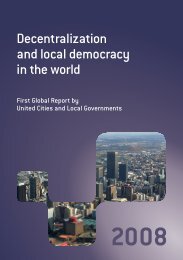Making Cities Resilient Report 2012
Making Cities Resilient Report 2012
Making Cities Resilient Report 2012
You also want an ePaper? Increase the reach of your titles
YUMPU automatically turns print PDFs into web optimized ePapers that Google loves.
ANNEXES<br />
Annex 2<br />
Terminology<br />
Adaptation<br />
The adjustment in natural or human systems in response<br />
to actual or expected climatic stimuli or their effects,<br />
which moderates harm or exploits beneficial opportunities<br />
(United Nations Framework Convention on Climate Change<br />
- UNFCCC). This definition addresses the concerns of climate<br />
change. Many disaster risk reduction measures can<br />
directly contribute to better adaptation.<br />
Disaster<br />
A serious disruption of the functioning of a community or a<br />
society involving widespread human, material, economic<br />
or environmental losses and impacts, which exceeds the<br />
ability of the affected community or society to cope using<br />
its own resources. Disasters are often described as a result<br />
of the combination of: the exposure to a hazard; the conditions<br />
of vulnerability that are present; and insufficient<br />
capacity or measures to reduce or cope with the potential<br />
negative consequences.<br />
Disaster Risk Management (DRM)<br />
Disaster risk management is the systematic process of<br />
using administrative directives, organisations, and operational<br />
skills and capacities to implement strategies, policies<br />
and improved coping capacities to lessen the adverse<br />
impacts of hazards and the possibility of disaster. It aims<br />
to avoid, lessen or transfer the adverse effects of hazards<br />
through activities and measures for prevention, mitigation<br />
and preparedness.<br />
Disaster Risk Reduction (DRR)<br />
Disaster risk reduction is the concept and practice of reducing<br />
disaster risks through systematic efforts to analyse<br />
and manage the causal factors of disasters, including<br />
through reduced exposure to hazards, lessened vulnerability<br />
of people and property, wise management of land<br />
and the environment, and improved preparedness for<br />
adverse events (guided by the global policy set out in the<br />
Hyogo Framework for Action 2005-2015: Building the Resilience<br />
of Nations and Communities to Disasters).<br />
Exposure<br />
People, property, systems, or other elements present in<br />
hazard zones that are thereby subject to potential losses.<br />
Mitigation<br />
The lessening or limitation of the adverse impacts of<br />
hazards and related disasters. Mitigation measures encompass<br />
engineering techniques and hazard-resistant<br />
construction as well as improved environmental policies<br />
and public awareness. (Note that in climate change policy,<br />
“mitigation” is defined differently, being the term used for<br />
the reduction of greenhouse gas emissions that are the<br />
source of climate change).<br />
Natural Hazard<br />
Natural process or phenomenon that may cause loss of<br />
life, injury or other health impacts, property damage, loss<br />
of livelihoods and services, social and economic disruption,<br />
or environmental damage. Natural hazard can be classified<br />
according to their geological, hydrometeorological or biological<br />
origin and characterized by their magnitude or intensity,<br />
speed of onset, duration, and area of extent. For example,<br />
earthquakes have short durations and usually affect<br />
a relatively small region, whereas droughts are slow to develop<br />
and fade away and often affect large regions. In some<br />
cases hazards may be coupled, as in the flood caused by a<br />
hurricane or the tsunami that is created by an earthquake.<br />
(Note: Natural hazards are a sub-set of all hazards, although<br />
for the purpose of this report the terms ‘hazard’ and ‘natural<br />
hazard’ are used to denote the same thing.)<br />
Preparedness<br />
The knowledge and capacities developed by governments,<br />
professional response and recovery organizations, communities<br />
and individuals to effectively anticipate, respond<br />
to, and recover from, the impacts of likely, imminent or current<br />
hazard events or conditions. Preparedness is based<br />
on a sound analysis of disaster risks and good linkages<br />
with early warning systems, and includes such activities<br />
as contingency planning, stockpiling of equipment and<br />
supplies, the development of arrangements for coordination,<br />
evacuation and public information, and associated<br />
training and field exercises. The related term “readiness”<br />
describes the ability to quickly and appropriately respond<br />
when required.<br />
Recovery<br />
The restoration, and improvement where appropriate, of<br />
facilities, livelihoods and living conditions of disaster-affected<br />
communities, including efforts to reduce disaster<br />
risk factors.<br />
<strong>Making</strong> <strong>Cities</strong> <strong>Resilient</strong> <strong>Report</strong> <strong>2012</strong> | 91

















